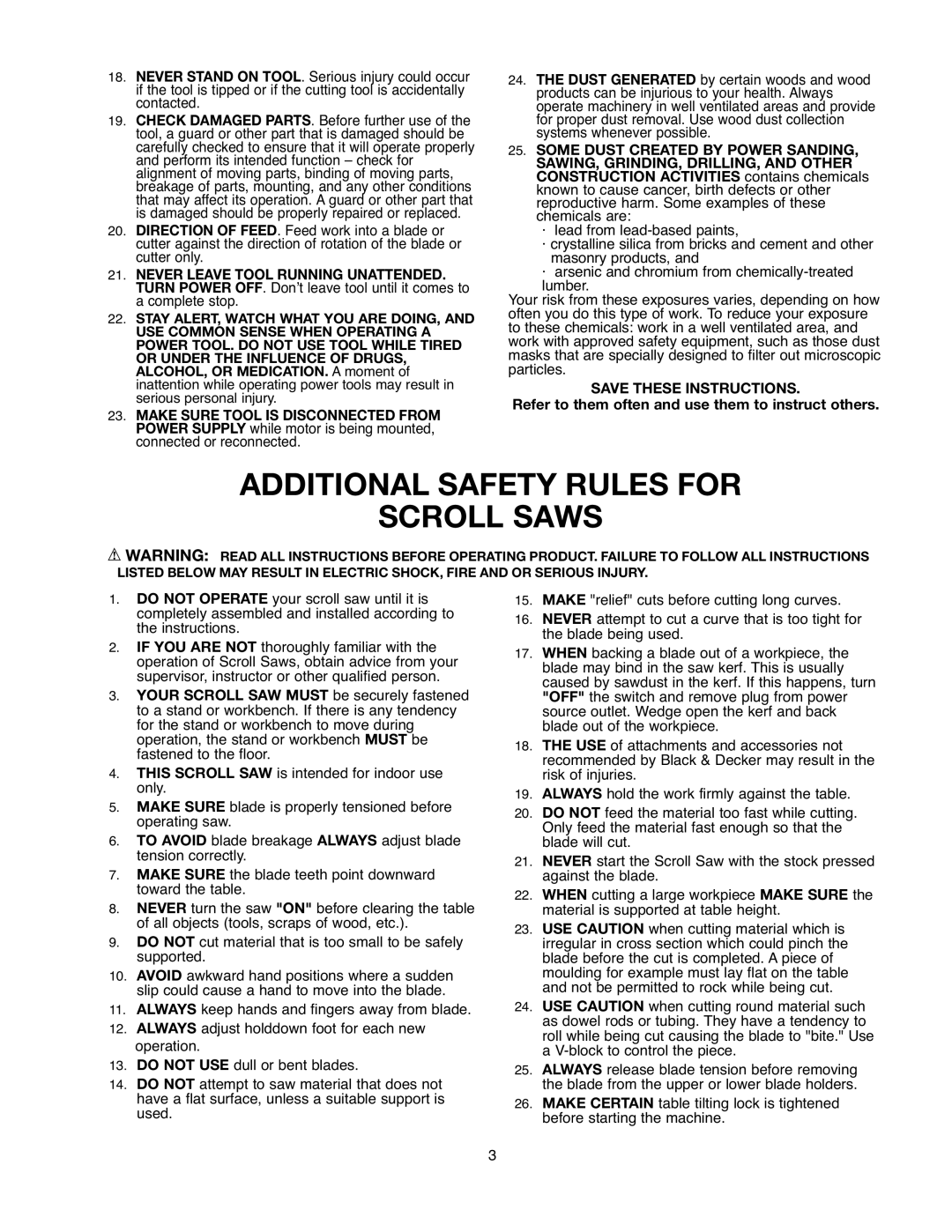18.NEVER STAND ON TOOL. Serious injury could occur if the tool is tipped or if the cutting tool is accidentally contacted.
19.CHECK DAMAGED PARTS. Before further use of the tool, a guard or other part that is damaged should be carefully checked to ensure that it will operate properly and perform its intended function – check for alignment of moving parts, binding of moving parts, breakage of parts, mounting, and any other conditions that may affect its operation. A guard or other part that is damaged should be properly repaired or replaced.
20.DIRECTION OF FEED. Feed work into a blade or cutter against the direction of rotation of the blade or cutter only.
21.NEVER LEAVE TOOL RUNNING UNATTENDED. TURN POWER OFF. Donʼt leave tool until it comes to a complete stop.
22.STAY ALERT, WATCH WHAT YOU ARE DOING, AND USE COMMON SENSE WHEN OPERATING A POWER TOOL. DO NOT USE TOOL WHILE TIRED OR UNDER THE INFLUENCE OF DRUGS, ALCOHOL, OR MEDICATION. A moment of inattention while operating power tools may result in serious personal injury.
23.MAKE SURE TOOL IS DISCONNECTED FROM POWER SUPPLY while motor is being mounted, connected or reconnected.
24.THE DUST GENERATED by certain woods and wood products can be injurious to your health. Always operate machinery in well ventilated areas and provide for proper dust removal. Use wood dust collection systems whenever possible.
25.SOME DUST CREATED BY POWER SANDING, SAWING, GRINDING, DRILLING, AND OTHER CONSTRUCTION ACTIVITIES contains chemicals known to cause cancer, birth defects or other reproductive harm. Some examples of these chemicals are:
·lead from
·crystalline silica from bricks and cement and other masonry products, and
·arsenic and chromium from
Your risk from these exposures varies, depending on how often you do this type of work. To reduce your exposure to these chemicals: work in a well ventilated area, and work with approved safety equipment, such as those dust masks that are specially designed to filter out microscopic particles.
SAVE THESE INSTRUCTIONS.
Refer to them often and use them to instruct others.
ADDITIONAL SAFETY RULES FOR
SCROLL SAWS
![]() WARNING: READ ALL INSTRUCTIONS BEFORE OPERATING PRODUCT. FAILURE TO FOLLOW ALL INSTRUCTIONS LISTED BELOW MAY RESULT IN ELECTRIC SHOCK, FIRE AND OR SERIOUS INJURY.
WARNING: READ ALL INSTRUCTIONS BEFORE OPERATING PRODUCT. FAILURE TO FOLLOW ALL INSTRUCTIONS LISTED BELOW MAY RESULT IN ELECTRIC SHOCK, FIRE AND OR SERIOUS INJURY.
1.DO NOT OPERATE your scroll saw until it is completely assembled and installed according to the instructions.
2.IF YOU ARE NOT thoroughly familiar with the operation of Scroll Saws, obtain advice from your supervisor, instructor or other qualified person.
3.YOUR SCROLL SAW MUST be securely fastened to a stand or workbench. If there is any tendency for the stand or workbench to move during operation, the stand or workbench MUST be fastened to the floor.
4.THIS SCROLL SAW is intended for indoor use only.
5.MAKE SURE blade is properly tensioned before operating saw.
6.TO AVOID blade breakage ALWAYS adjust blade tension correctly.
7.MAKE SURE the blade teeth point downward toward the table.
8.NEVER turn the saw "ON" before clearing the table of all objects (tools, scraps of wood, etc.).
9.DO NOT cut material that is too small to be safely supported.
10.AVOID awkward hand positions where a sudden slip could cause a hand to move into the blade.
11.ALWAYS keep hands and fingers away from blade.
12.ALWAYS adjust holddown foot for each new operation.
13.DO NOT USE dull or bent blades.
14.DO NOT attempt to saw material that does not have a flat surface, unless a suitable support is used.
15.MAKE "relief" cuts before cutting long curves.
16.NEVER attempt to cut a curve that is too tight for the blade being used.
17.WHEN backing a blade out of a workpiece, the blade may bind in the saw kerf. This is usually caused by sawdust in the kerf. If this happens, turn "OFF" the switch and remove plug from power source outlet. Wedge open the kerf and back blade out of the workpiece.
18.THE USE of attachments and accessories not recommended by Black & Decker may result in the risk of injuries.
19.ALWAYS hold the work firmly against the table.
20.DO NOT feed the material too fast while cutting. Only feed the material fast enough so that the blade will cut.
21.NEVER start the Scroll Saw with the stock pressed against the blade.
22.WHEN cutting a large workpiece MAKE SURE the material is supported at table height.
23.USE CAUTION when cutting material which is irregular in cross section which could pinch the blade before the cut is completed. A piece of moulding for example must lay flat on the table and not be permitted to rock while being cut.
24.USE CAUTION when cutting round material such as dowel rods or tubing. They have a tendency to roll while being cut causing the blade to "bite." Use a
25.ALWAYS release blade tension before removing the blade from the upper or lower blade holders.
26.MAKE CERTAIN table tilting lock is tightened before starting the machine.
3
